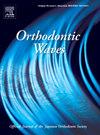大豆黄酮诱导实验性牙齿运动后牙周膜细胞骨形态发生蛋白2和矮子相关转录2的表达
IF 0.5
Q4 DENTISTRY, ORAL SURGERY & MEDICINE
引用次数: 1
摘要
【摘要】目的分析大豆苷元对实验性牙齿移动(EXTM)后骨形态发生蛋白-2 (BMP-2)和矮子相关转录因子2 (Runx2)表达的影响。材料与方法36只Wistar大鼠随机分为EXTM组和EXTM加大豆苷元组(EXTM+DZ组)。EXTM+DZ组大鼠在EXTM后给予大豆苷元(10 mg/kg/d)治疗。显微计算机断层扫描(CT)显示骨密度(BMD)、骨体积与组织体积之比(BV/TV)和复发率。免疫组化染色检测BMP-2和Runx2的组织病理学变化。用10 μg/mL大豆苷元对人pdlc进行张力处理。实时聚合酶链反应和酶联免疫吸附法证实大豆苷元对BMP-2和Runx2的表达。结果与EXTM组相比,EXTM+DZ组复发率明显降低,BMD和BV/TV均明显升高。EXTM+DZ组BMP-2和Runx-2阳性细胞比例高于EXTM组。此外,大豆苷元以时间依赖性的方式上调BMP-2和Runx2的mRNA表达和蛋白水平。结论大豆苷元可通过BMP-2和Runx2的表达降低复发率。本文章由计算机程序翻译,如有差异,请以英文原文为准。
Daidzein induces bone morphogenetic protein-2 and runt-related transcription 2 on periodontal ligament cells after experimental tooth movement
ABSTRACT Purpose To analysis, daidzein increases the expression of bone morphogenetic protein-2 (BMP-2) and runt-related transcription factor 2 (Runx2) after experimental tooth movement (EXTM). Materials and Methods 36 Wistar rats were randomly divided into the EXTM group and EXTM with daidzein group (EXTM+DZ group). After EXTM, the rats in the EXTM+DZ group were treated with daidzein (10 mg/kg/day). Micro-computed tomography (CT) analysis revealed the bone mineral density (BMD), ratio of bone volume to tissue volume (BV/TV), and ratio of relapse. Histopathological changes were examined by immunohistochemical staining for BMP-2 and Runx2. Human PDLCs were subjected to tension force and treated with 10 μg/mL daidzein. The expression of BMP-2 and Runx2 by daidzein was confirmed by real-time polymerase chain reaction and enzyme-linked immunosorbent assay. Results The EXTM+DZ group showed a significantly decreased ratio of relapse and increased BMD and BV/TV as compared to the EXTM group. The ratio of BMP-2 – and Runx-2 –positive cells in the EXTM+DZ group was higher than that in the EXTM group. Moreover, daidzein upregulated the mRNA expression and protein levels of BMP-2 and Runx2 in a time-dependent manner. Conclusion These results suggested that daidzein decreased the ratio of relapse through BMP-2 and Runx2 expression.
求助全文
通过发布文献求助,成功后即可免费获取论文全文。
去求助
来源期刊

Orthodontic Waves
DENTISTRY, ORAL SURGERY & MEDICINE-
CiteScore
0.40
自引率
0.00%
发文量
0
期刊介绍:
Orthodontic Waves is the official publication of the Japanese Orthodontic Society. The aim of this journal is to foster the advancement of orthodontic research and practice. The journal seeks to publish original articles (i) definitive reports of wide interest to the orthodontic community, (ii) Case Reports and (iii) Short Communications. Research papers stand on the scientific basis of orthodontics. Clinical topics covered include all techniques and approaches to treatment planning. All submissions are subject to peer review.
 求助内容:
求助内容: 应助结果提醒方式:
应助结果提醒方式:


